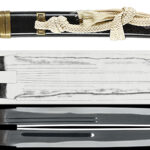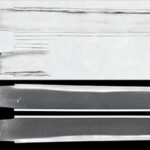Ordering number:24502
Tanto in Shirasaya with Koshirae (NBTHK Tokubetsu Kicho Token)
Signature: Naniwa-jū Gassan Sadayoshi
Ansei 6 Nen Shogatsu Hi (January 1859)
浪◻️住月山貞吉
安政六年正月日
At our company, we classify swords into four categories: Saijyo Saku, Jyojyo Saku, Jyo Saku, and Regular Saku, based on the craftsmanship of the swordsmith.
This piece is ranked as Jyojyo Saku (superior grade) for works by Gassan Sadayoshi.
The sword has been polished.
Habaki: Single gold-foil habaki.
Blade Length: 15.9 cm (6.26 in)
Curvature: Uchi-zori (slight inward curvature)
Mekugi Holes: 1
Width at Base (Motohaba): 2.07 cm (0.81 in)
Thickness (Kasane): 0.67 cm (0.26 in)
Sword Weight: 95 grams (0.21 lbs)
Era: January of Ansei 6 (1859).
Shape:A slightly small tanto.
Jigane:The steel is finely forged, close to nioi-deki, with small nie (martensite crystals).
Hamon:The temper line is in a gunome-midare pattern, and the boshi (tip) returns in a small rounded shape (komaru).
Features:Although small in size, this tanto features a well-executed hamon, showcasing high craftsmanship.
Koshirae:
Fuchikashira: Made of iron with gold inlaid patterns.
Saya: Decorated in brown with gold cloud patterns, with a high-relief carving of a pair of quail in gold at the rear.
Kojiri: Iron with gold floral designs.
Menuki: Family crest of Hoshiumebachi (a star within a plum flower) with yellow accents.
Kogatana: Made of shibuichi, engraved with patterns.
Aoi Art’s Comment:Gassan Sadayoshi, from the lineage of Dewa Gassan, was also influenced by Suishinshi Masahide’s school. He lived in Osaka and began making swords around Tenpo 6 (1835). He passed away in February of Meiji 3 (1870) at the age of 70.
This piece, featuring an active gunome-midare hamon, was likely made with a koshirae from a much later period, reflecting its historical context. In 1858, the Ansei Purge took place under the leadership of Ii Naosuke, leading to the arrest and execution of many political figures critical of his policies. This event set the stage for Ii’s assassination in the Sakuradamon Incident outside Edo Castle.
NBTHK Tokubetsu Kicho Token
Aoi Art’s estimation paper.
Whole oshigata.
Price:450,000JPY
Order Form
Related Items:
 Tanto: Kinseimaru Fujiwara Hidenaga (NBTHK Tokubetsu Kicho Token)
Tanto: Kinseimaru Fujiwara Hidenaga (NBTHK Tokubetsu Kicho Token)
 Wakizashi (Sunnobi Tanto) : Sakuyo Gohara Ju Nobushige(March 1859)(NBTHK Hozon Token)
Wakizashi (Sunnobi Tanto) : Sakuyo Gohara Ju Nobushige(March 1859)(NBTHK Hozon Token)
 Tanto:Gassan Sadakatsu Kinsaku(Kao)(NBTHK Tokubetsu Hozon Token)
Tanto:Gassan Sadakatsu Kinsaku(Kao)(NBTHK Tokubetsu Hozon Token)
 Tanto:Echigo no Kami Fujiwara Kunitomo(NBTHK Tokubetsu Hozon Token)
Tanto:Echigo no Kami Fujiwara Kunitomo(NBTHK Tokubetsu Hozon Token)
 Tanto: Gassan Sadakazu (Kokuin "Sada")(NBTHK Tokubetsu Hozon Token)
Tanto: Gassan Sadakazu (Kokuin "Sada")(NBTHK Tokubetsu Hozon Token)
 Tanto: Sakuyou Bakkashi Hosokawa Masayoshi(NBTHK Tokubetsu Hozon Token)
Tanto: Sakuyou Bakkashi Hosokawa Masayoshi(NBTHK Tokubetsu Hozon Token)







